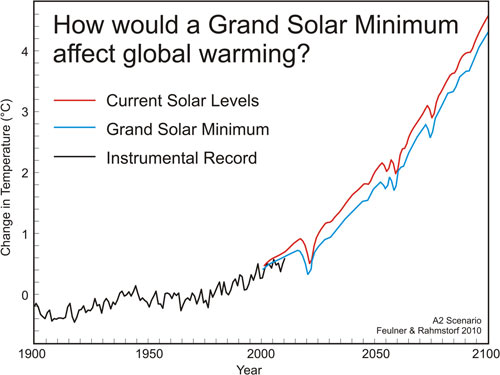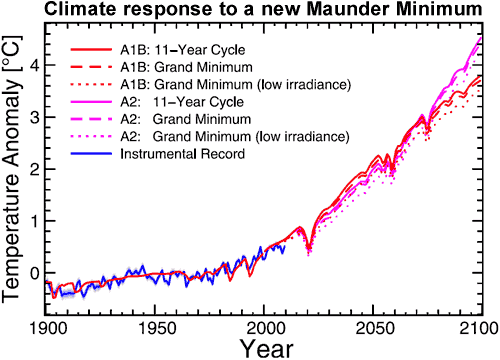How would a Solar Grand Minimum affect global warming?
Posted on 16 June 2011 by John Cook
Solar physicists have issued a prediction that the sun may be entering a period of unusually low activity called a grand minimum. This has climate skeptics speculating that solar 'hibernation' may be our get-out-of-jail-free card, cancelling out any global warming from our CO2 emissions. However, peer-reviewed research has examined this very scenario, "On the effect of a new grand minimum of solar activity on the future climate on Earth" (Feulner & Rahmstorf 2010). What they found was even if the sun fell into a grand minimum, global temperature would be diminished by no more than 0.3°C. The sun is not our get-out-of-jail-free card.
Figure 1: Global mean temperature anomalies 1900 to 2100 relative to the period 1961 to 1990 for the A2 scenario. The red line represents temperature change for current solar levels, the blue line represents temperature change at Maunder Minimum levels. Observed temperatures from NASA GISS until 2010 are also shown (black line) (Feulner 2010).
Feulner 2010 simulates what would happen if the sun fell to Maunder Minimum levels in the 21st Century. To include the effect of greenhouse gas emissions, they assume either A1B or A2 scenarios (IPCC TAR). A1B is a more optimistic scenario where carbon dioxide emissions continue to rise in the early 21st Century, stabilise mid-century then fall in the latter-21st Century. A2 is somewhat more pessimistic, projecting carbon dioxide emissions to continue growing throughout the 21st Century. Unfortunately, the latest data on CO2 emissions indicates we're tracking towards the worst case scenario.
Two methods are used to determine how low total solar irradiance (TSI) fell during the Maunder Minimum. Ice core measurements of beryllium indicate a less variable TSI while modelling from solar magnetic flux show a greater decrease in TSI during the Maunder Minimum. In Feulner 2010, both solar reconstructions are used as shown in Figure 2 below. The magenta lines are for the A2 emission scenario, the red line for the A1B scenario.
The important feature is the comparison between the solid line (with no solar change) to the dotted and dashed lines (the two Maunder Minimum scenarios). Just to be conservative (James Hansen was right!), in Figure 1 above, I used the version with more solar variability in order to show the option where the solar minimum has the greatest effect.

Figure 2: Global mean temperature anomalies 1900 to 2100 relative to the period 1961 to 1990 for the A1B (red lines) and A2 (magenta lines) scenarios and for three different solar forcings corresponding to a typical 11-year cycle (solid line) and to a new Grand Minimum with solar irradiance corresponding to recent reconstructions of Maunder-minimum irradiance (dashed line) and a lower irradiance (dotted line), respectively. Observed temperatures from NASA GISS until 2009 are also shown (blue line) (Feulner 2010).
For both the A1B and A2 emission scenario, the effect of a Maunder Minimum on global temperature is minimal. The most likely impact of a Maunder Minimum by 2100 would be a decrease in global temperature of 0.1°C with a maximum reduction of warming by 0.3°C. Compare this to global warming between 3.7°C (A1B scenario) to 4.5°C (A2 scenario).
Update 16 June: I've added the Figure 1 Grand Solar Minimum graphic to our list of high-rez graphics, free to use on other websites.
Update 17 June: Many thanks to DaneelOlivaw who created a Spanish version of Figure 1 (note - one of these days, I'll reprogram the Climate Graphics resource so it'll be possible to add translations).































 Arguments
Arguments























 0
0  0
0






Comments